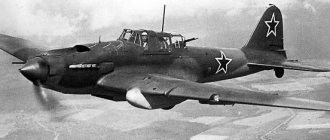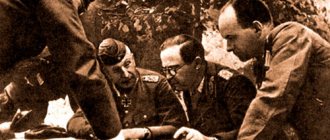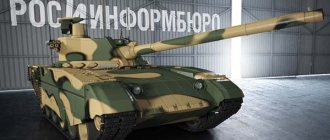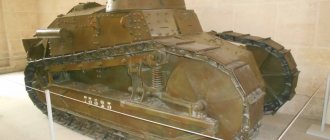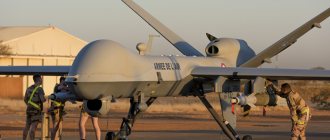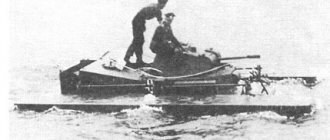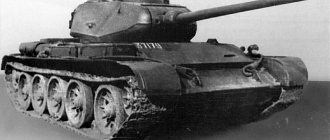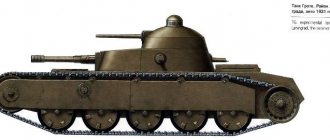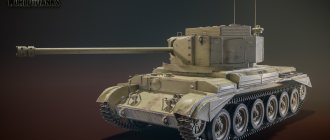T-34
The tank gained enormous fame after this battle.
The Soviet T-34 tank was quite good, but it was inferior in many respects to the German T-IV and Panther medium tanks. A frontal attack on a heavy "Tiger" for any single 34 was similar to suicide. However, the T-34s were superior to German tanks in speed and maneuverability on rough terrain. And most importantly, they were simpler and cheaper to produce, and therefore for 190 “Panthers” and 134 “Tigers” from the Wehrmacht there were about 2 thousand Soviet T-34s.
It was simple, reliable and fast.
Armed with a 76-mm gun, the T-34 could not penetrate the frontal armor of the German “kittens”. Soviet tank crews recalled how shells bounced off German armor. Therefore, the crews had to enter from the flank or rear and shoot down the tracks. Tankers tried to set up ambushes to gain an advantage over heavier vehicles. The numerical superiority and experience of the Soviet crews made it possible in that battle to snatch victory from the hands of a much better armed enemy, albeit at a high price.
"Shermans" on the Kursk Bulge
Deliveries of American M4A2 tanks under Lend-Lease to the USSR began at the end of 1942. However, due to manufacturing defects (in particular, engine injectors), they did not immediately begin to enter the troops. Only a few units received tanks of this type in the spring of 1943, but one of them was destined to take part in the most famous tank battle of the Great Patriotic War.
Fire brigade on fire arc
One of the first units to receive new American tanks was the 229th Separate Tank Regiment (SRT). The first 31 tanks of this type reached the unit by April 10, 1943, and by the beginning of July the number of serviceable M4A2s had grown to 38 units. The regiment met July 1943 as part of the 48th Army. On July 1, the regiment was listed in reserve, located in the village of Perekhozheye. The regiment was commanded by Lieutenant Colonel Merkulov, and the chief of staff was Major Bogatyrev.
Scheme of the German offensive on the northern front of the Kursk Bulge. The 229th separate tank regiment was destined to collide with units of the XLI German tank corps in the Maloarkhangelsk area
By July 5, 1943, the regiment was in the Kazakovka area. By the beginning of the defensive phase of the Battle of Kursk, the regiment had 1.2 refills of fuel and lubricants, three ammunition loads for M4A2 and 4 daily food allowances. The Shermans were lucky, as the spearhead of the first German attack went far to the west.
However, it was impossible to sit still for long. Quite quickly, the decision was made to raise reserves to repel the German attack on Ponyri. The commander of the 48th Army ordered the 229th Regiment to be brought closer to the front. By night march, the regiment arrived at a new location in the Ivanovka region (20 km northeast of Maloarkhangelsk) at 04:00 on July 7.
Still, the M4A2 tanks did not have the chance to fight as part of the 48th Army. On July 9, the commander of the Central Front ordered the transfer of the 229th Regiment to the 13th Army, which was in the way of the German XLI Panzer Corps. By 03:00 on July 10, the regiment concentrated in the Leski area (6 km southeast of Maloarkhangelsk), coming at the disposal of the commander of the 15th Rifle Corps (sk). He ordered the defense of the Tinyakovsky state farm in the zone of the 74th Rifle Division (SD). By July 11, the regiment reported that it had 39 tanks in service.
The situation in the Maloarkhangelsk area on July 9–10, 1943
The enemy continued to advance. At 10:00 on July 11, the regiment received an order to capture the line Height 255.6 - Height 238.6 - Trosna on the right flank of the 74th Infantry Division and hold out until the arrival of the infantry. The attack was carried out not only without infantry cover, but also without reconnaissance of the area or reconnaissance. The result was predictable: when reaching a height of 255.6, the first company of the regiment was fired at from a height of 248.8 and lost three tanks burnt out. The company continued its advance, but became involved in a battle with 15 German tanks and up to two battalions of infantry on the eastern outskirts of Protasovo. 10 tanks managed to break through the defenses and reach the southern slope of height 255.6.
The second company was supposed to support the first, but was late for the battle and could not do this. Fortunately, the third company arrived in the area of height 260.3, from where it was able to cover with fire the retreat of the first company in the direction of Vavilovka. By this time, the second company had arrived, but its fire was ineffective. The third company was also fired upon by the enemy and was forced to hide behind the heights. At 19:00, on the orders of the chief of staff of the 15th Infantry Corps, the third and fourth companies quickly attacked height 255.6. The chief of staff did not just throw tanks forward, but was able to achieve coordinated actions between tanks and infantry. As a result, the Shermans successfully took the heights, and the infantry was able to approach and gain a foothold at the line.
The next day the enemy broke through to the village of Grinievka. The 229th Regiment received an order, together with the 78th Infantry Regiment (SP) of the 74th Infantry Division, to drive the enemy out of the village. The second company of the tank regiment was allocated to support the infantry. The company reached the northern outskirts, but was fired upon from Protasovo and was forced to retreat. The attack was not repeated. On the night of July 13, all companies of the regiment went to the western outskirts of the village of Vavilovka. During two days of fighting, 8 tanks in the regiment burned down, and 11 more were knocked out. Personnel losses were 15 killed and 13 wounded. The commander of the BTiMV of the Central Front laid the blame for the failure on the headquarters of the 229th Regiment, which was unable to coordinate actions not only with the infantry and artillery, but also between its own companies.
Claims for success even in this situation were not too modest: the regiment knocked out 6 enemy tanks and self-propelled guns, destroyed 5 anti-tank guns, 8 machine guns, 2 mortar batteries, as well as up to 350 soldiers and officers.
Heroes also appeared in these battles. Many crew members were awarded for the destruction of machine gun nests and enemy infantry. M4A2 radio operator junior sergeant D.I. Aksenov destroyed a medium tank, a wedge (probably referring to the radio-controlled Bogrvard wedge), 9 machine gun points and 19 Germans. Tank loading junior sergeant P.I. Bogachev and radio operator junior sergeant V.M. Kochetkova destroyed an enemy medium tank, four machine gun emplacements and up to 13 Germans. Tank of loading senior sergeant V.A. Volkova destroyed one anti-tank gun, a bunker, and up to 17 Germans. Tank of junior driver P.P. Bugaevsky destroyed an anti-tank gun and 14 Germans.
The result of the battles on July 9–12, 1943. Soviet counterattacks did not produce any significant results, but the Germans were not allowed to approach Maloarkhangelsk either.
Radio operator junior sergeant O.V. earned medals “For Military Merit.” Goryachev - a member of the crew that destroyed 4 mortar batteries, one machine gun point and up to 20 Germans and evacuated three tanks from the battlefield, driver-mechanic senior sergeant F.V. Lukyanov, whose crew knocked out an enemy tank, destroyed the anti-tank gun, 2 machine guns, and up to 20 Germans, assistant driver foreman V.N. Mamkin, whose crew destroyed 2 machine-gun crews and 20 Germans, crushing anti-tank missiles and two dugouts with tracks.
Repairmen also received awards. For example, V.S. Lebedev received the medal “For Courage” for carrying out 5 medium repairs and restoring 2 tanks right on the battlefield. Technician-Lieutenant P.K. Ivanov received the medal "For Courage" for organizing the evacuation of five tanks from the battlefield on July 11, returning them to service by the end of the day on July 13. For personal merit, he received the medal “For Courage” and driver-mechanic junior sergeant P.M. Vozhansky, who remained at the combat post despite being wounded. Radio operator senior sergeant D.F. Pugachenko took two radio stations from the damaged tanks.
Breathing before the rush
Fortunately for the battered 229th Retaliation Division, the enemy forces were also exhausted by that time. On July 12, the German 18th Panzer Division (TD) received orders to retreat. On July 13–14, a lull followed, during which it was possible to patch up the materiel. Reports from the 74th Infantry Division noted that the enemy was shelling the front line of defense, but losses from this were minimal. From the side of the Soviet infantry, the German trenches were fired upon by snipers. The division's reconnaissance noticed 12 vehicles and 8 tanks heading in the direction of Ponyri.
At 13:00 on July 14, the order was given to prepare for the offensive again. This time the tanks interacted with infantry from the 360th rifle regiment of the 74th infantry division. The tanks were ordered to attack immediately, together with the infantry, at 05:30. At 05:15, an artillery attack began, which was supposed to weaken the German defenses.
During the night of July 15, the 229th detachment reached its initial positions 2 km east of the village of Sidorovka. A couple of tanks were still repaired, and the regiment had 22 combat-ready Shermans. In the morning the regiment attacked in the direction of Sidorovka - Pavlovka - Soglasny.
Soviet tank crews and a captured Pz.Kpfw.III tank with a short-barreled 75-mm cannon, captured at the Kursk Bulge. Judging by complaints about the enemy's use of cumulative shells, these tanks were mistaken for "Tigers"
By 7 a.m. the infantry reached the villages of Pavlovka and Petrovka. The tanks reached the village of Semyonovka without incident, but when they reached the Maloarkhangelsk-Protasovo highway, the tanks were subjected to heavy artillery fire, as well as an attack by a group of enemy tanks with infantry. Having lost 3 tanks burned out and 5 damaged, the regiment continued to advance further. The score was not dry: in this battle the crew of gunner Junior Sergeant I.T. Antonov announced that an enemy self-propelled gun had been knocked out.
The infantry also had a hard time. At 17:00, after units of the 360th rifle regiment were attacked with the support of four German tanks, the infantrymen were forced to abandon their occupied lines, retreating to a stream flowing between Protasovo and Pavlovka. At night, the regiment commander ordered small groups to infiltrate the Protasovo area and gain a foothold on the western outskirts.
By 17:00 on July 16, the infantry had bypassed Protasovo from the west and entrenched itself 500–600 meters southwest of Soglasny. A group of 19–20 tanks prevented further advance. The infantry did not count on the help of their tanks against such a force: the order was given to form tank destroyer teams to resist German counterattacks. At the front line, it was ordered to have anti-tank guns for direct fire, as well as individual means of combat: anti-tank grenades and Molotov cocktails. Instead of mobile anti-tank guns, the M4A2s were used to reinforce infantry attacks. The infantrymen were ordered to let the tanks coming from behind through their formations, and then quickly move behind them and keep up. However, the tanks were not helpless against their own kind: in the battles of July 15–16, the tank of radio operator Sergeant M.T. Mikhankina laid claim to a destroyed enemy medium tank.
Diagram of the vulnerable spots of the Sherman tank when fired by cumulative shells of 75 mm caliber. Due to the poor location of the ammunition, a hit in the fighting compartment had a high probability of destroying the tank
The 74th Infantry Division reported that day about two destroyed Tiger tanks, a self-propelled gun and two destroyed anti-tank guns. The enemy did not accept counterattacks that day, but conducted heavy artillery fire.
By 21:00 on July 16, M4A2 tanks finally reached Protasovo, but did not take the village. By 23:00 the fighting had ceased. The infantry of the 360th rifle regiment was ordered to conduct force reconnaissance at night towards the southern outskirts of Soglasny and capture the “tongue”, as well as equip an observation post west of Protasovo.
It came in handy the next day, when a battle broke out for the village. The enemy stubbornly resisted. By 18:00, one of the M4A2s was shot down west of Protasovo. On July 17, Protasovo was never taken, and the battered 74th Infantry Division decided to concentrate on the village of Soglasny, covering it from the southeast and southwest.
The chief of staff of the BTiMV again criticized the coherence of the actions of the 229th Regiment and the 74th Infantry Division. Although the tanks and infantry reached Protasovo together, the surrender of the lines was not worked out, and the regimental headquarters did not use the reserve.
There are 10 tanks left in the regiment, just over a quarter of the original number. The infantry also suffered serious losses: 275 active bayonets remained in the 74th Infantry Division, and only 173 in the 360th Infantry Division. The infantrymen were also tired after two weeks of almost continuous fighting. The division's documents indicate that even with sufficient artillery and aviation preparation, the thinned companies could not make a decisive push. The losses of commanders up to the regiment commander, who were forced by personal example to encourage fighters to attack, were also heavy. The enemy withdrew heavy artillery to the rear and sat well in the old Soviet trenches, also using destroyed tanks as firing points. The enemy had a mobile group of self-propelled guns (the brigade documents called them “Ferdinands,” although this is unlikely), which could effectively repel even tank attacks.
Results of the battles July 14–18. The enemy was forced to retreat across the Neruch River, leaving Protasovo and Soglasny
However, things did not go as smoothly as it seemed for the Germans. A prisoner of war from the 7th company of the 195th infantry regiment (infantry regiment) said that in his company, out of 180 active bayonets, only 60 remained, and that on July 16, the regiment was ordered to withdraw to the Neruch River. Based on these testimonies, the division commander decided to regroup and pursue the enemy, but the tanks no longer took part in this. On July 18, the 229th separate tank regiment left the subordination of the 15th infantry regiment and was transferred to the 17th infantry regiment.
In total, during the battles as part of the 74th Infantry Division, the 229th Regiment lost 14 vehicles burned out and 17 damaged, as well as 117 personnel. On July 18, the regiment had 8 tanks on the move. All damaged tanks were evacuated.
During these battles, the commander of the 3rd tank company, Captain D.S. Matveev received the Order of the Red Star for the fact that his company knocked out 6 tanks, two self-propelled guns, and a wedge. To the platoon of Lieutenant V.G. Sokolov had two of these tanks and one self-propelled gun, for which he received the order. Another tank belongs to the crew of the company commander, Lieutenant S.M. Shuvalov, for which he also received an order.
In these battles, many radio operators were awarded for impeccable communications: junior sergeant D.A. Velichenko received the medal “For Military Merit”, junior sergeant A.M. Kuligin, Sergeant D.F. Pugachenko, senior sergeant M.B. Dryabkov and senior sergeant S.D. Zheleznov received the medal “For Courage”. Military technician 2nd rank I.S. Meter received the medal “For Military Merit” for repairing 25 tank radios No. 19 during the entire battle.
British radio stations No. 19, registered on numerous Lend-Lease equipment, were issued with inscriptions dubbed in Russian
The driver mechanics whose tanks went through heavy battles without accidents also received awards: junior sergeant S.A. Zernov (who, in addition, evacuated two damaged tanks under enemy fire) and senior sergeant I.A. Ivanushkin (who also evacuated two damaged vehicles) received the medal “For Military Merit,” senior sergeant F.D. Akimov (the crew also announced the destruction of the tankette), and junior sergeant I.P. Loginov received the medal “For Courage”.
The repairmen did not go without awards. Captain S.A. Glukharev received the Order of the Red Star for organizing the evacuation of 26 vehicles from the battlefield and 60 medium and current repairs. Senior Sergeant A.I. Latyshev received the medal “For Military Merit” for carrying out 7 medium and 11 current repairs, and also taught the rest of the unit’s controllers. The repair team of Brigadier Senior Sergeant V.A. Teptsova carried out 8 current repairs and 9 medium repairs, of which 5 were carried out under enemy fire. Teptsov, as well as senior sergeant Z.Z. Ishchenko, junior sergeant P.E. Saburov, junior sergeant A.M. Khardikov, junior sergeant V.M. Grachev, Red Army soldier V.I. Zhuravlev, Red Army soldier N.D. Semenov, Red Army soldier A.I. Kharitonov, Red Army soldier I.M., Vorobyov received medals “For Military Merit.” Lieutenant I.A. Amirajibi received the Medal of Courage for organizing the clearance of five passages and the evacuation of seven tanks. Technician Lieutenant K.A. During the entire period of fighting, Arzhankov organized the evacuation and repair of 20 tanks. Numerous delivery drivers of fuels and lubricants, ammunition, and food who worked under enemy fire also received awards.
The last "Shermans" of the Kursk Bulge
Left with a quarter of its tanks, the 229th Regiment was not going to sit in reserve. Already on July 18, the regiment took part in the attack together with the 17th Infantry Corps, but to no avail. Another attack on July 20 cost the regiment 4 tanks.
The unit could not hold out for so long, and it was decided to hand over the remaining M4A2s to the 237th detachment and send the 229th detachment for reorganization. On July 23, the 237th Regiment received 10 M4A2 tanks, as well as materiel from the 84th and 43rd Regiment.
Location of the 237th Tank Regiment near the village of Chermoshnoye July 21–24, 1943
By July 24, the regiment was at the disposal of the commander of the 70th Army. The 237th detachment had 7 Shermans on the move, as well as 13 T-34s and 7 T-70s. At 10:20 on July 25, the tanks went on the attack along with the infantry of the 188th and 43rd infantry regiments, freely occupying Novoryzhkovsky and Krasnoe Banner. Working with the infantry, the tanks crossed the Nezhivka stream and occupied Pokhvisnevo. Inspired by success, the units rushed ahead of their neighbors and were subjected to strong attacks from the flanks from Krasnikovo, Topkovo, and from height 260.1. As a result of the attack, four M4A2s, three T-34s and one T-70 were burned out, two more M4A2s, 5 T-34s, and 2 T-70s were shot down. The destroyed tanks continued to fire from the spot, supporting the infantry of the 188th rifle regiment, which managed to take height 260.1. During the battles, the regiment reported a destroyed Ferdinand and 20 guns of various types. In total, 25 tanks in the regiment were hit and burned, 7 tankers were killed and 22 were wounded.
The last operational M4A2 belonged to the company commander, Lieutenant Shevchenko, whose crew in this battle destroyed 3 anti-tank missiles, 2 bunkers, 1 mortar battery, 5 machine gun points, and up to 60 enemy soldiers and officers. Shevchenko was awarded the Order of the Patriotic War, 1st degree, for these battles. The commander of the Sherman platoon, junior lieutenant G.I., was awarded the Order of the Red Star. Filimonov.
Map of the Pokhvisnevo region - height 260.1 on July 31, 1943
The commander of the other M4A2, junior lieutenant M.A. Mironov was awarded the medal “For Courage” for this battle. Driver mechanics Sergeant N.E. Nazarenko and the aforementioned Loginov distinguished themselves by boldly driving their tanks towards two self-propelled guns that blocked the regiment’s path, receiving for this the Order of the Red Star. Also in the battles on July 25, M4A2 crew members, junior driver mechanics Sergeant G.A., earned medals “For Courage.” Kyakhrin and Red Army soldier V.P. Levchenko, radio operators Sergeant M.T. Eremenko and junior sergeant A.S. Guryev, loading senior sergeant Ya.S. Zorin and Sergeant I.N. Zakharov.
On July 26, the regiment was ordered to move all combat-ready tanks to the Pokhvisnevo area and support the attack of the 43rd Regiment on an unnamed height east of Hill 260.1. Tanks from Shevchenko’s company went with the infantry, where in addition to the last M4A2 there was a T-34 and several T-70s. The tanks were counterattacked by 8–13 German vehicles, but the counterattacks were repulsed and by the end of the day the tanks had reached their target. On that day, Shevchenko’s M4A2 burned out and one T-34 was shot down and evacuated. There were almost no casualties in personnel, only one junior commander was wounded. The regiment recorded one Tiger and one Ferdinand to its credit. On July 27, the 106th Rifle Division was on the defensive; 9 T-34s, 4 T-70s, and one M4A2 were evacuated from the battlefield.
German instructions for combating Shermans. The "Tiger" confidently penetrates the frontal armor from 800 meters - from this distance the "Sherman" is capable of penetrating only the side of the enemy
Unlike the reports of the 229th Regiment, the story with the Tigers is consistent here. Just these days, the 505th heavy tank battalion fought north of the Novoryzhkovsky - Pokhvisnevo - Nezhivka area. From July 20 to July 31, the number of Tigers in the regiment dropped from 19 to 3, so the tanks of the 237th Regiment actually had the opportunity to knock out one of them.
On July 28, the regiment was withdrawn to the army reserve and concentrated in the forest south of the Svetly Danube. Damaged and running materiel was also collected here. All combat-ready tanks (T-34, T-70, and either another T-70 or M4A2) were transferred to the 251st detachment. On August 3, the remaining tanks were transferred to the 251st Regiment. By July 29, the M4A2 was listed in the documents as in need of major repairs.
Despite the fact that the documents of the 237th Regiment praised the organization of joint actions of infantry and tanks, according to the commander of the armored fighting and combat vehicles of the Central Front, the commander of the 237th Regiment commanded his tanks exceptionally poorly, giving orders by radio from an observation post 3–5 km from the field battle, as a result of which it was impossible to organize assistance with artillery and infantry. Reconnaissance was not organized, which is why the tanks of the 1st and 2nd companies unexpectedly ran into the anti-tank line. Instead of timely introducing a company of machine gunners and a platoon of anti-tank rifles into battle, the latter were used to protect the headquarters and rear areas.
"Sherman" destroyed by an explosion of ammunition
The results of the battle showed that the key to success in a tank battle lies in joint work with infantry, artillery and reconnaissance. Exposing the sides of tanks, especially medium ones, to discreet anti-tank batteries is not the most sensible idea. The fire hazard of the early M4A2s also showed itself: the T-34s and T-70s fighting side by side burned much less often. However, the repairmen of the 229th Regiment proved that if spare parts are available, the Shermans can be kept in service for quite a long time, even in intense battles. British radio stations No. 19 were also useful, maintaining reliable communications in battle. In terms of general reliability parameters, American tanks were on par with the T-34, and the career of these vehicles in the Red Army promised to be long.
Su-152
The most formidable self-propelled gun of the Second World War.
At the time of the Battle of Kursk, the Soviet Union had a truly formidable and universal weapon against any, even the heaviest armored vehicles of the Wehrmacht - the SU-152 self-propelled artillery mount. The design of this weapon was so successful that the armored vehicle fighter went into production almost unchanged.
The consequences of the hit look terrible.
The self-propelled gun was armed with an incredibly powerful 152 mm ML-20S howitzer. Unfortunately, when the Battle of Kursk began, the Su-152 crews experienced a serious shortage of armor-piercing shells. However, this circumstance did not help the Wehrmacht much. After all, a 43-kilogram high-explosive fragmentation shell thrown from the 152nd gun still destroyed the vast majority of enemy tanks.
The design of the self-propelled guns turned out to be unique and incredibly successful.
The hits from such shells made huge holes in German tanks, tore off their turrets, and tore out pieces of the hull. The shots of the SU-152 hits are both frightening and terribly fascinating. Interestingly, the SU-152 was the only Soviet vehicle capable of stopping the super-heavy German Ferdinands with invulnerable 200 mm armor. Soviet soldiers nicknamed the lethal self-propelled gun "St. John's wort". There was only one problem. During the Battle of Kursk, only 24 such vehicles took part in the battle.
With warm greetings - “Bison” and “St. John’s wort”
The vehicles of the 1529th heavy self-propelled artillery regiment entered the battle on July 7. From closed positions, self-propelled guns fired at German troops, who almost broke through the second defensive line of Shumilov’s army.
By coincidence, the name of the self-propelled gun “St. John’s wort” from the 1529th regiment later became a household name for all SU-152
The Soviet units needed to hold out, the Germans needed to finally connect with the group advancing in the main direction. Covering its flank was the main task of the Kempf group, which it had not yet begun to fulfill. Three days of fierce fighting cost both the Soviet and German troops dearly, so the 6th and 19th Panzer Divisions simply did not have enough strength.
The Germans planned on July 8 to supplement them with the 7th tank, which was still “slipping” on the right flank. But it turned out differently. At night, Shumilov's guards launched counterattacks in the area of the Batratskaya Dacha state farm, the fighting for which continued throughout the day on July 8. The Germans quickly realized that their infantry could not withstand Soviet attacks without tanks. The plan was quickly “replayed” and in the first half of the day the 7th Panzer first sent its own tanks into battle, and by the evening the Tigers assigned to them.
Having habitually led the battle group, the Tigers moved forward, not suspecting that they were already being carefully examined through the sights by the gunners of the 3rd SU-152 battery. The regiment's vehicles had their own names, and it so happened that the Zubr and St. John's wort self-propelled guns entered the battle with the Tigers.
Judging by the award list of the gunner "St. John's wort", the battle was not very long. “The enemy, with a force of up to 12 tanks and an infantry battalion, tried to occupy an advantageous position (height 191.2) in the area of our battle formations, 6 German tigers were moving ahead.
Comrade Mikhailov, aiming his gun exactly at the target, helped put the tanks to flight, while 3 T-6 tanks were destroyed and 4 light tanks were damaged.” T-6 are "Tigers", as they were called in Soviet documents throughout the war.
Most likely, this was the very first battle between the Tigers and the Soviet St. John's Boys. In the scale of the Battle of Kursk it seems insignificant, but like thousands of other small skirmishes, it undermined the German offensive. Due to the fact that on July 8, 1943, the enemy tank division was bogged down in the battles for the “Batratskaya Dacha” and could not free itself, on that day the Kempf group was never able to connect with the troops of Hermann Hoth in the main direction. As a result, he had to divert his own tank forces to protect the flanks. For now - continuing to advance.
Pz. Kpfw.VI "Tiger"
The formidable German “cat”, who was feared by tankers on all fronts.
It would be “impolite” not to remember the enemy’s formidable equipment, which, however, still did not help the Wehrmacht win. First of all, the Pz deserves mention. Kpfw.VI "Tiger", which was much feared on all allied fronts. Powerful armor made it invulnerable to 45 mm artillery fire. The 76 mm cannon could penetrate the side or stern only at pistol shot distance. The Tiger's gun fired up to 8 rounds per minute with a fairly experienced crew. It is noteworthy that the tank had a “soft suspension” and (unexpectedly!) was controlled using a steering wheel, rather than the levers familiar to most tankers. But the tank did not have a system for protecting and cleaning the rollers from snow and dirt, which played a cruel joke on this formidable vehicle during the war in the USSR.
Mine Curse of the 19th Division
The 19th Division generally deserved the “palm” in the bad luck of the current day. Most of the “Tigers” that they got were not even able to reach the eastern bank of the Seversky Donets. Another excerpt from German documents: “We did not have at our disposal maps with minefields that were laid by German troops. We only had two mutually exclusive field plans, which turned out to be both wrong.” As a result, initially two Tigers were blown up by German mines immediately after their deployment, and two more a little later. Moreover, the latter moved through an area that was considered cleared of mines.
And then the explosions followed one after another. Three tanks stumbled into a carelessly cleared minefield and went out of action. Two trucks went up in the air on a “cleared” road, from which another 120 mines were then removed, which allegedly should not have been there.
The attempt to push through the Soviet defense with what was left of the “tiger” company of the 19th Panzer Division was costly - by nightfall there was only one intact tank left in it. Of course, a mine explosion did not guarantee that a heavy tank would be scrapped. But in the conditions of this battle, not only every unit of armored vehicles counted, but also every minute.
The result of the first day of the offensive of the army group “Kempf” was an outright failure. All that the Germans managed to do was capture several bridgeheads on the eastern bank, which by evening they could not even combine into one large one.
But that was only the beginning.
Self-propelled gun "Ferdinand"
German self-propelled guns destroyed by the Soviet military on the Kursk Bulge.
The already mentioned German self-propelled artillery unit “Ferdinand” is the same one whose frontal armor was not damaged by any shots (except for the SU-152 gun). It was a truly formidable weapon. The Pak 43/2 rifled gun of 88 mm caliber allowed the Germans to knock out any Soviet tanks at a distance of up to 3 km. Sound scary? Undoubtedly.
Soviet tank crews against the background of a captured gun.
But the Ferdinand was incredibly heavy, which significantly reduced its combat capabilities. Also, the self-propelled guns did not have additional weapons. Of course, with proper use, both disadvantages were leveled out. During Operation Citadel, the Wehrmacht irretrievably lost 39 of these self-propelled guns. Some of them were taken as trophies by the Red Army. By the way, “Ferdinand” was of great interest to specialists from the Main Armored Directorate of the Red Army.
The beginning of the battle and its course
German troops, following Hitler's instructions, decided to launch the first air strikes, which were supposed to weaken the defensive system of the Soviet Union. But the Red Army carried out good artillery preparation, which in turn weakened the initial attack of the Wehrmacht.
Central Front
The artillery commander on the Central Front, Kazakov, said that artillery preparation was one of the most important stages in the Battle of Kursk. The Soviet army could observe the enemy's artillery points, so it was able to quickly prepare a counterattack using its artillery, as well as combat aircraft.
Tank supporting infantry
Thanks to operational reconnaissance work, the Red Army received more reliable data about the location of Nazi troops, and therefore was able to more quickly respond to their attacks and organize its defense. With the help of a powerful blow to the concentration of Nazi troops, as well as to artillery units, the Red Army was able to disorganize the Wehrmacht offensive, as well as significantly destroy multiple enemy artillery installations and significantly weaken its offensive force.
Voronezh Front
As for the Voronezh Front, its units and combat formations were supposed to suppress the advance of enemy tanks, as well as their infantry. On a strip of more than 100 km, special fortifications were built, as well as combat units of infantry and anti-tank artillery, which were able to effectively fight against the offensive forces of the enemy.
Expert opinion
Konstantin Pavlovich Vetrov
Assistant and Advisor to the Minister of State Control of the USSR, Hero of Socialist Labor, historian, Doctor of Historical Sciences. Author of many scientific works on the history of the Soviet Union.
The main strength of the German units were tank formations, which operated together with infantry. But due to the active work of Soviet artillery, it was possible to neutralize a significant part of the central forces of the German armies that were advancing on the Voronezh Front.
Tank battles
During the Battle of Kursk, the largest tank battle in human history took place. It happened near the village of Prokhorovka. German tank formations took quite strong offensive steps in order to push back the tank formations of the Red Army.
After the victory of the Red Army in the Battle of Kursk, the strategic initiative finally passed to the Soviet troops.
From the USSR side, almost 600 tanks, as well as 130 thousand infantry, took part in the tank battle near Prokhorovka. The Wehrmacht forces had 311 tanks and artillery units, and were also supported by 70 thousand infantry.
Sturmpanzer IV
A controversial but incredibly powerful German weapon.
In conclusion, another interesting car. The German 150-mm howitzer StuH 43 L/12 was used both to support infantry and as a tank destroyer (in exceptional cases). The debut of this type of technology actually took place on the Kursk Bulge. Overall, the weapon performed quite mediocre. The armor protected the Sturmpanzer IV only from medium Soviet calibers. By the way, one of these howitzers is now on display in Kubinka, near Moscow.
Source
"Tigers" in the fiery rain
Despite the fact that Citadel was a German offensive operation, it was Soviet troops who made the first move. On the night of July 5, guns, mortars and guards rocket mortars began artillery counter-preparation. The effect of their strike on areas where German troops were concentrated is usually called “stunning” in Soviet literature. And this is true - including in relation to the area of operations of the 7th Guards Army.
In the area of the bridgehead near Mikhailovka, artillery bombardment “reached” one of the two crossings available there. The first attack from the bridgehead on the Soviet positions failed, then the Germans tried to transfer assault guns and Tigers there. But a bridge span collapsed under one of the self-propelled guns, and the second crossing was also put out of action. The main battle group of the 6th German Tank Division, together with the attached Tigers, remained on the western (German) coast and were eventually forced to take a roundabout route - through the crossing of neighbors from the 19th Tank Division, who received a kit for building a bridge with a carrying capacity of 60 tons.
From the report of the 19th Panzer Division: “The bridge for the Tigers was half ready. At this time, the Russians begin a well-organized shelling with artillery, mortars and flanking machine guns along the crossing. Despite the darkness, the fire was very accurate.” The Germans finally completed the crossing, but encountered a new problem, because of which the commander of the 7th Panzer Division, Hans von Funk, generally decided that the Tigers were safest to cross by ford. True, they did not go far - exactly to the first minefield, where they stopped waiting for sappers who were supposed to clear the passage.
Actually, because of the mines, Funk went ford, and not because of the Soviet ones, but because of the German ones. The coordination between the strike forces and the sappers who had to remove the mines for the troops to pass through turned out to be simply disgusting. For example, the crossing near the village of Solomatino in the sector of the 19th division was blocked by six tanks, which were blown up by their own mines immediately after leaving the bridge.
Results and consequences of offensive operations and battles
Historians call this period of time in World War II a fundamental turning point. As a result of successful offensive operations, the Red Army was able not only to move from defense to offensive, but also to liberate significant territories, including the entire left bank of Ukraine, as well as the capital Kyiv.
Artillery crew fires at the enemy
After the Red Army defeated the Wehrmacht forces at Kursk, German troops were no longer able to conduct strategic offensive operations. Adolf Hitler blamed his field marshals as well as generals for the failure of these large-scale military operations and offensives. Many generals were removed from their positions and were replaced. Thanks to the results of the Battle of Kursk, the plans of the German command were thwarted, which became a real turning point and the beginning of the end for the Wehrmacht and the entire Third Reich.
Also, due to the fact that significant Wehrmacht forces, including military equipment, were defeated in the Battle of Kursk, Anglo-American troops were able to gain a foothold in Africa, and also in the future be able to deploy their forces in Europe. The collapse of the fascist bloc began. Italy withdrew from it and joined the Allied forces. The USSR became the main authoritative country in the anti-Hitler coalition.
Offensive
On July 13, the German army went on the defensive. The Red Army attacked, pushing the Germans further and further, and by July 14 the front line had moved up to 25 km. Having battered the German defensive capabilities, on July 18 the Soviet army launched a counterattack with the goal of defeating the Kharkov-Belgorod German group. The Soviet front of offensive operations exceeded 600 km. On July 23, they reached the line of the German positions occupied before the offensive.
By August 3, the Soviet army consisted of: 50 rifle divisions, 2.4 thousand tanks, more than 12 thousand guns. On August 5 at 18:00 Belgorod was liberated from the Germans. From the beginning of August, the battle for the city of Oryol was fought, and on August 6 it was liberated. On August 10, soldiers of the Soviet army cut the Kharkov-Poltava railway road during the offensive Belgorod-Kharkov operation. On August 11, the Germans attacked in the vicinity of Bogodukhov, weakening the tempo of fighting on both fronts.
Heavy fighting lasted until August 14. On August 17, Soviet troops approached Kharkov, starting a battle on its outskirts. German troops carried out the final offensive in Akhtyrka, but this breakthrough did not affect the outcome of the battle. On August 23, an intense assault on Kharkov began.
This day itself is considered the day of the liberation of Kharkov and the end of the Battle of Kursk. Despite the actual fights with the remnants of the German resistance, which lasted until August 30.
